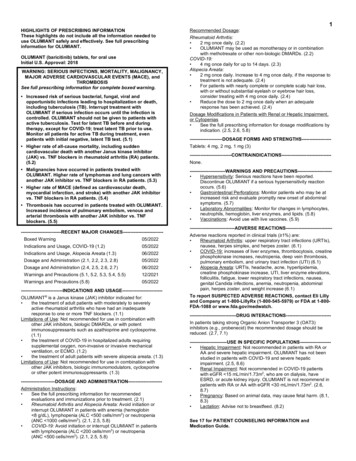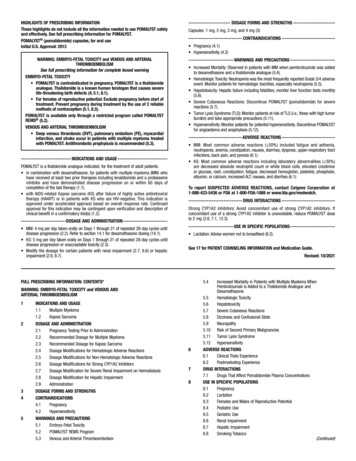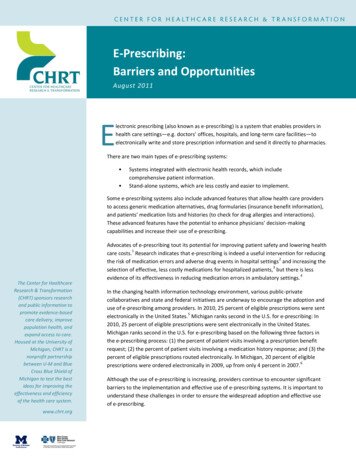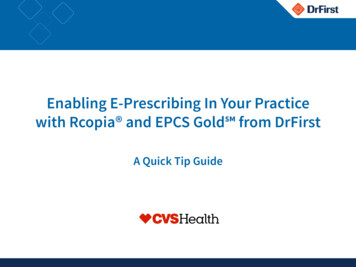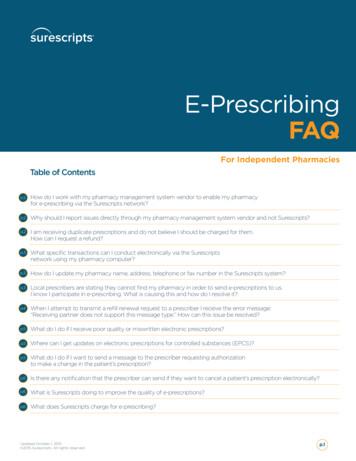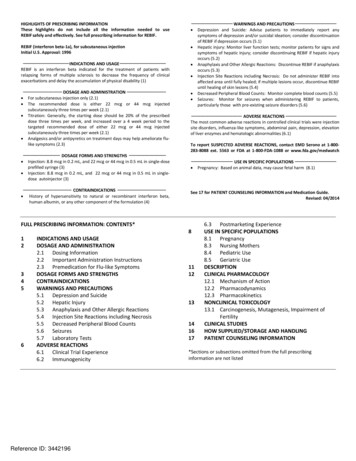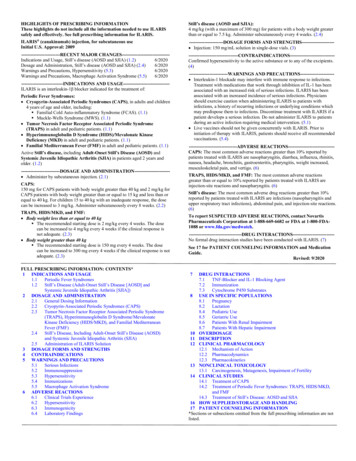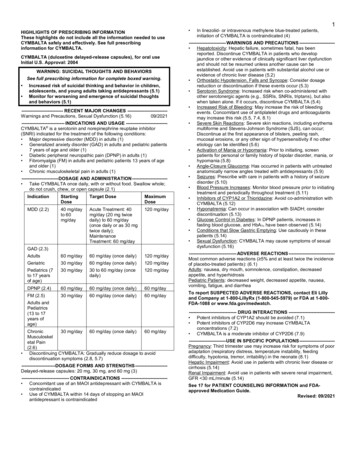
Transcription
1HIGHLIGHTS OF PRESCRIBING INFORMATIONThese highlights do not include all the information needed to useCYMBALTA safely and effectively. See full prescribinginformation for CYMBALTA.CYMBALTA (duloxetine delayed-release capsules), for oral useInitial U.S. Approval: 2004WARNING: SUICIDAL THOUGHTS AND BEHAVIORSSee full prescribing information for complete boxed warning. Increased risk of suicidal thinking and behavior in children,adolescents, and young adults taking antidepressants (5.1)Monitor for worsening and emergence of suicidal thoughtsand behaviors (5.1)--------------------------- RECENT MAJOR CHANGES -------------------------Warnings and Precautions, Sexual Dysfunction (5.16)09/2021---------------------------- INDICATIONS AND USAGE --------------------------CYMBALTA is a serotonin and norepinephrine reuptake inhibitor(SNRI) indicated for the treatment of the following conditions: Major depressive disorder (MDD) in adults (1) Generalized anxiety disorder (GAD) in adults and pediatric patients7 years of age and older (1) Diabetic peripheral neuropathic pain (DPNP) in adults (1) Fibromyalgia (FM) in adults and pediatric patients 13 years of ageand older (1) Chronic musculoskeletal pain in adults (1)------------------------DOSAGE AND ADMINISTRATION---------------------- Take CYMBALTA once daily, with or without food. Swallow whole;do not crush, chew, or open capsule (2.1)IndicationStartingDoseTarget DoseMaximumDoseMDD (2.2)40 mg/dayto 60mg/dayAcute Treatment: 40mg/day (20 mg twicedaily) to 60 mg/day(once daily or as 30 mgtwice daily);MaintenanceTreatment: 60 mg/day120 mg/dayAdults60 mg/day60 mg/day (once daily)120 mg/dayGeriatric30 mg/day60 mg/day (once daily)120 mg/dayPediatrics (7to 17 yearsof age)30 mg/day30 to 60 mg/day (oncedaily)120 mg/dayDPNP (2.4)60 mg/day60 mg/day (once daily)60 mg/dayFM (2.5)30 mg/day60 mg/day (once daily)60 mg/dayGAD (2.3)Adults andPediatrics(13 to 17years ofage) Chronic30 mg/day60 mg/day (once daily)60 mg/dayMusculoskeletal Pain(2.6)Discontinuing CYMBALTA: Gradually reduce dosage to avoiddiscontinuation symptoms (2.8, 5.7)----------------------DOSAGE FORMS AND STRENGTHS--------------------Delayed-release capsules: 20 mg, 30 mg, and 60 mg (3)------------------------------- CONTRAINDICATIONS ----------------------------- Concomitant use of an MAOI antidepressant with CYMBALTA iscontraindicated Use of CYMBALTA within 14 days of stopping an MAOIantidepressant is contraindicated In linezolid- or intravenous methylene blue-treated patients,initiation of CYMBALTA is contraindicated (4)------------------------ WARNINGS AND PRECAUTIONS ---------------------- Hepatotoxicity: Hepatic failure, sometimes fatal, has beenreported. Discontinue CYMBALTA in patients who developjaundice or other evidence of clinically significant liver dysfunctionand should not be resumed unless another cause can beestablished. Avoid use in patients with substantial alcohol use orevidence of chronic liver disease (5.2) Orthostatic Hypotension, Falls and Syncope: Consider dosagereduction or discontinuation if these events occur (5.3) Serotonin Syndrome: Increased risk when co-administered withother serotonergic agents (e.g., SSRIs, SNRIs, triptans), but alsowhen taken alone. If it occurs, discontinue CYMBALTA (5.4) Increased Risk of Bleeding: May increase the risk of bleedingevents. Concomitant use of antiplatelet drugs and anticoagulantsmay increase this risk (5.5, 7.4, 8.1) Severe Skin Reactions: Severe skin reactions, including erythemamultiforme and Stevens-Johnson Syndrome (SJS), can occur;Discontinue at the first appearance of blisters, peeling rash,mucosal erosions, or any other sign of hypersensitivity if no otheretiology can be identified (5.6) Activation of Mania or Hypomania: Prior to initiating, screenpatients for personal or family history of bipolar disorder, mania, orhypomania (5.8) Angle-Closure Glaucoma: Has occurred in patients with untreatedanatomically narrow angles treated with antidepressants (5.9) Seizures: Prescribe with care in patients with a history of seizuredisorder (5.10) Blood Pressure Increases: Monitor blood pressure prior to initiatingtreatment and periodically throughout treatment (5.11) Inhibitors of CYP1A2 or Thioridazine: Avoid co-administration withCYMBALTA (5.12) Hyponatremia: Can occur in association with SIADH; considerdiscontinuation (5.13) Glucose Control in Diabetes: In DPNP patients, increases infasting blood glucose, and HbA1c have been observed (5.14) Conditions that Slow Gastric Emptying: Use cautiously in thesepatients (5.14) Sexual Dysfunction: CYMBALTA may cause symptoms of sexualdysfunction (5.16)------------------------------- ADVERSE REACTIONS -----------------------------Most common adverse reactions ( 5% and at least twice the incidenceof placebo-treated patients): (6.1)Adults: nausea, dry mouth, somnolence, constipation, decreasedappetite, and hyperhidrosisPediatric Patients: decreased weight, decreased appetite, nausea,vomiting, fatigue, and diarrheaTo report SUSPECTED ADVERSE REACTIONS, contact Eli Lillyand Company at 1-800-LillyRx (1-800-545-5979) or FDA at 1-800FDA-1088 or -- DRUG INTERACTIONS ----------------------------- Potent inhibitors of CYP1A2 should be avoided (7.1) Potent inhibitors of CYP2D6 may increase CYMBALTAconcentrations (7.2) CYMBALTA is a moderate inhibitor of CYP2D6 (7.9)------------------------USE IN SPECIFIC POPULATIONS----------------------Pregnancy: Third trimester use may increase risk for symptoms of pooradaptation (respiratory distress, temperature instability, feedingdifficulty, hypotonia, tremor, irritability) in the neonate (8.1)Hepatic Impairment: Avoid use in patients with chronic liver disease orcirrhosis (5.14)Renal Impairment: Avoid use in patients with severe renal impairment,GFR 30 mL/minute (5.14)See 17 for PATIENT COUNSELING INFORMATION and FDAapproved Medication Guide.Revised: 09/2021
2FULL PRESCRIBING INFORMATION: WARNING: SUICIDAL THOUGHTS AND BEHAVIORS1INDICATIONS AND USAGE2DOSAGE AND ADMINISTRATION2.1Important Administration Instructions2.2Dosage for Treatment of Major Depressive Disorder inAdults2.3Dosage for Treatment of Generalized Anxiety Disorder2.4Dosage for Treatment of Diabetic Peripheral NeuropathicPain in Adults2.5Dosage for Treatment of Fibromyalgia2.6Dosage for Treatment of Chronic Musculoskeletal Pain inAdults2.7Dosage in Patients with Hepatic Impairment or SevereRenal Impairment2.8Discontinuing CYMBALTA2.9Switching a Patient to or from a Monoamine OxidaseInhibitor (MAOI) Intended to Treat Psychiatric Disorders2.10 Use of CYMBALTA with Other MAOIs such as Linezolid orMethylene Blue3DOSAGE FORMS AND STRENGTHS4CONTRAINDICATIONS5WARNINGS AND PRECAUTIONS5.1Suicidal Thoughts and Behaviors in Children,Adolescents, and Young Adults5.2Hepatotoxicity5.3Orthostatic Hypotension, Falls and Syncope5.4Serotonin Syndrome5.5Increased Risk of Bleeding5.6Severe Skin Reactions5.7Discontinuation Syndrome5.8Activation of Mania/Hypomania5.9Angle-Closure Glaucoma5.10 Seizures5.11 Increases in Blood Pressure5.12 Clinically Important Drug Interactions5.13 Hyponatremia5.14 Use in Patients with Concomitant Illness5.15 Urinary Hesitation and Retention5.16 Sexual Dysfunction6ADVERSE REACTIONS6.1Clinical Trials Experience6.2Postmarketing Experience7DRUG INTERACTIONS7.1Inhibitors of CYP1A27.2Inhibitors of CYP2D67.3Dual Inhibition of CYP1A2 and CYP2D67.4Drugs that Interfere with Hemostasis (e.g., NSAIDs,Aspirin, and Warfarin)7.5Lorazepam7.6TemazepamDrugs that Affect Gastric AcidityDrugs Metabolized by CYP1A2Drugs Metabolized by CYP2D6Drugs Metabolized by CYP2C9Drugs Metabolized by CYP3ADrugs Metabolized by CYP2C19Monoamine Oxidase Inhibitors (MAOIs)Serotonergic DrugsAlcoholCNS DrugsDrugs Highly Bound to Plasma Protein8USE IN SPECIFIC POPULATIONS8.1Pregnancy8.2Lactation8.4Pediatric Use8.5Geriatric Use8.6Gender8.7Smoking Status8.8Race8.9Hepatic Impairment8.10 Severe Renal Impairment9DRUG ABUSE AND DEPENDENCE9.2Abuse9.3Dependence10OVERDOSAGE10.1 Signs and Symptoms10.2 Management of Overdose11DESCRIPTION12CLINICAL PHARMACOLOGY12.1 Mechanism of Action12.2 Pharmacodynamics12.3 Pharmacokinetics13NONCLINICAL TOXICOLOGY13.1 Carcinogenesis, Mutagenesis, Impairment of Fertility14CLINICAL STUDIES14.1 Overview of the Clinical Trials14.2 Major Depressive Disorder in Adults14.3 Generalized Anxiety Disorder14.4 Diabetic Peripheral Neuropathic Pain in Adults14.5 Fibromyalgia14.6 Chronic Musculoskeletal Pain in Adults16HOW SUPPLIED/STORAGE AND HANDLING16.1 How Supplied16.2 Storage and Handling17PATIENT COUNSELING INFORMATION* Sections or subsections omitted from the full prescribing informationare not listed.
3FULL PRESCRIBING INFORMATIONWARNING: SUICIDAL THOUGHTS AND BEHAVIORSAntidepressants increased the risk of suicidal thoughts and behavior in children, adolescents, and youngadults in short-term studies. These studies did not show an increase in the risk of suicidal thoughts andbehavior with antidepressant use in patients over age 24; there was a reduction in risk with antidepressantuse in patients aged 65 and older [see Warnings and Precautions (5.1)].In patients of all ages who are started on antidepressant therapy, monitor closely for worsening, and foremergence of suicidal thoughts and behaviors. Advise families and caregivers of the need for closeobservation and communication with the prescriber [see Warnings and Precautions (5.1)].1INDICATIONS AND USAGECYMBALTA is indicated for the treatment of: Major depressive disorder in adultsGeneralized anxiety disorder in adults and pediatric patients 7 years of age and olderDiabetic peripheral neuropathic pain in adultsFibromyalgia in adults and pediatric patients 13 years of age and olderChronic musculoskeletal pain in adults2DOSAGE AND ADMINISTRATION2.1Important Administration InstructionsAdminister CYMBALTA orally (with or without meals) and swallow whole. Do not chew or crush, and do not open thedelayed-release capsule and sprinkle its contents on food or mix with liquids because these actions might affect theenteric coating. If a dose of CYMBALTA is missed, take the missed dose as soon as it is remembered. If it is almost timefor the next dose, skip the missed dose and take the next dose at the regular time. Do not take two doses of CYMBALTAat the same time.2.2Dosage for Treatment of Major Depressive Disorder in AdultsThe recommended starting dosage in adults with MDD is 40 mg/day (given as 20 mg twice daily) to 60 mg/day (giveneither once daily or as 30 mg twice daily). For some patients, it may be desirable to start at 30 mg once daily for 1 week,to allow patients to adjust to CYMBALTA before increasing to 60 mg once daily. While a 120 mg/day dose was shown tobe effective, there is no evidence that doses greater than 60 mg/day confer any additional benefits. Periodically reassessto determine the need for maintenance treatment and the appropriate dosage for such treatment.2.3Dosage for Treatment of Generalized Anxiety DisorderRecommended Dosage in Adults Less than 65 Years of AgeFor most adults less than 65 years of age with GAD, initiate CYMBALTA 60 mg once daily. For some patients, it may bedesirable to start at 30 mg once daily for 1 week, to allow patients to adjust to CYMBALTA before increasing to 60 mgonce daily. While a 120 mg once daily dosage was shown to be effective, there is no evidence that doses greater than60 mg/day confer additional benefit. Nevertheless, if a decision is made to increase the dosage beyond 60 mg once daily,increase dosage in increments of 30 mg once daily. Periodically reassess to determine the continued need formaintenance treatment and the appropriate dosage for such treatment.Recommended Dosage in Geriatric PatientsIn geriatric patients with GAD, initiate CYMBALTA at a dosage of 30 mg once daily for 2 weeks before considering anincrease to the target dose of 60 mg/day. Thereafter, patients may benefit from doses above 60 mg once daily. If adecision is made to increase the dose beyond 60 mg once daily, increase dose in increments of 30 mg once daily. Themaximum dose studied was 120 mg per day.Recommended Dosage in Pediatric Patients 7 to 17 Years of AgeInitiate CYMBALTA in pediatric patients 7 to 17 years of age with GAD at a dosage of 30 mg once daily for 2 weeksbefore considering an increase to 60 mg once daily. The recommended dosage range is 30 to 60 mg once daily. Somepatients may benefit from dosages above 60 mg once daily. If a decision is made to increase the dose beyond 60 mgonce daily, increase dosage in increments of 30 mg once daily. The maximum dose studied was 120 mg per day.
42.4Dosage for Treatment of Diabetic Peripheral Neuropathic Pain in AdultsAdminister 60 mg once daily in adults with diabetic peripheral neuropathic pain. There is no evidence that doses higherthan 60 mg once daily confer additional significant benefit and the higher dosage is clearly less well tolerated. For patientsfor whom tolerability is a concern, a lower starting dose may be considered.Since diabetes is frequently complicated by renal disease, consider a lower starting dosage and gradual increase indosage for patients with renal impairment [see Dosage and Administration (2.7) and Use in Specific Populations (8.10)].2.5Dosage for Treatment of FibromyalgiaRecommended Dosage in AdultsThe recommended CYMBALTA dosage is 60 mg once daily in adults with fibromyalgia. Begin treatment at 30 mg oncedaily for 1 week, to allow patients to adjust to CYMBALTA before increasing to 60 mg once daily. Some patients mayrespond to the starting dosage. There is no evidence that dosages greater than 60 mg/day confer additional benefit, evenin patients who do not respond to a 60 mg/day dosage, and higher dosages were associated with a higher rate of adversereactions.Recommended Dosage in Pediatric Patients 13 to 17 Years of AgeThe recommended starting CYMBALTA dosage in pediatric patients 13-17 years of age with fibromyalgia is 30 mg oncedaily. The dosage may be increased to 60 mg once daily based on response and tolerability.2.6Dosage for Treatment of Chronic Musculoskeletal Pain in AdultsThe recommended CYMBALTA dosage is 60 mg once daily in adults with chronic musculoskeletal pain. Begin treatmentat 30 mg once daily for one week, to allow patients to adjust to CYMBALTA before increasing to 60 mg once daily. Thereis no evidence that higher dosages confer additional benefit, even in patients who do not respond to a 60 mg once dailydosage, and higher dosages are associated with a higher rate of adverse reactions [see Clinical Studies (14.6)].2.7Dosage in Patients with Hepatic Impairment or Severe Renal ImpairmentAvoid use in patients with chronic liver disease or cirrhosis [see Warnings and Precautions (5.14) and Use in SpecificPopulations (8.9)].Avoid use in patients with severe renal impairment, GFR 30 mL/minute [see Warnings and Precautions (5.14) and Use inSpecific Populations (8.10)].2.8Discontinuing CYMBALTAAdverse reactions after discontinuation of CYMBALTA, after abrupt or tapered discontinuation, include: dizziness,headache, nausea, diarrhea, paresthesia, irritability, vomiting, insomnia, anxiety, hyperhidrosis, and fatigue. A gradualreduction in dosage rather than abrupt cessation is recommended whenever possible [see Warnings and Precautions(5.7)].2.9Switching a Patient to or from a Monoamine Oxidase Inhibitor (MAOI) Intended to Treat PsychiatricDisordersAt least 14 days should elapse between discontinuation of an MAOI intended to treat psychiatric disorders and initiation oftherapy with CYMBALTA. Conversely, at least 5 days should be allowed after stopping CYMBALTA before starting anMAOI intended to treat psychiatric disorders [see Contraindications (4)].2.10Use of CYMBALTA with Other MAOIs such as Linezolid or Methylene BlueDo not start CYMBALTA in a patient who is being treated with linezolid or intravenous methylene blue because there is anincreased risk of serotonin syndrome. In a patient who requires more urgent treatment of a psychiatric condition, otherinterventions, including hospitalization, should be considered [see Contraindications (4)].In some cases, a patient already receiving CYMBALTA therapy may require urgent treatment with linezolid or intravenousmethylene blue. If acceptable alternatives to linezolid or intravenous methylene blue treatment are not available and thepotential benefits of linezolid or intravenous methylene blue treatment are judged to outweigh the risks of serotoninsyndrome in a particular patient, CYMBALTA should be stopped promptly, and linezolid or intravenous methylene bluecan be administered. The patient should be monitored for symptoms of serotonin syndrome for 5 days or until 24 hoursafter the last dose of linezolid or intravenous methylene blue, whichever comes first. Therapy with CYMBALTA may beresumed 24 hours after the last dose of linezolid or intravenous methylene blue [see Warnings and Precautions (5.4)].
5The risk of administering methylene blue by non-intravenous routes (such as oral tablets or by local injection) or inintravenous doses much lower than 1 mg/kg with CYMBALTA is unclear. The clinician should, nevertheless, be aware ofthe possibility of emergent symptoms of serotonin syndrome with such use [see Warnings and Precautions (5.4)].3DOSAGE FORMS AND STRENGTHSCYMBALTA is available as delayed-release capsules: 420 mg opaque green capsules imprinted with “Lilly 3235 20mg”30 mg opaque white and blue capsules imprinted with “Lilly 3240 30mg”60 mg opaque green and blue capsules imprinted with “Lilly 3270 60mg”CONTRAINDICATIONSThe use of MAOIs intended to treat psychiatric disorders with CYMBALTA or within 5 days of stopping treatment withCYMBALTA is contraindicated because of an increased risk of serotonin syndrome. The use of CYMBALTA within 14days of stopping an MAOI intended to treat psychiatric disorders is contraindicated [see Dosage and Administration (2.8)and Warnings and Precautions (5.4)].Starting CYMBALTA in a patient who is being treated with MAOIs such as linezolid or intravenous methylene blue is alsocontraindicated because of an increased risk of serotonin syndrome [see Dosage and Administration (2.9) and Warningsand Precautions (5.4)].5WARNINGS AND PRECAUTIONS5.1Suicidal Thoughts and Behaviors in Children, Adolescents, and Young AdultsPatients with major depressive disorder (MDD), both adult and pediatric, may experience worsening of their depressionand/or the emergence of suicidal ideation and behavior (suicidality) or unusual changes in behavior, whether or not theyare taking antidepressant medications, and this risk may persist until significant remission occurs. Suicide is a known riskof depression and certain other psychiatric disorders, and these disorders themselves are the strongest predictors ofsuicide. There has been a long-standing concern, however, that antidepressants may have a role in inducing worsening ofdepression and the emergence of suicidality in certain patients during the early phases of treatment.Pooled analyses of short-term placebo-controlled trials of antidepressant drugs (SSRIs and others) showed that thesedrugs increase the risk of suicidal thinking and behavior (suicidality) in children, adolescents, and young adults (ages 1824) with major depressive disorder (MDD) and other psychiatric disorders. Short-term studies did not show an increase inthe risk of suicidality with antidepressants compared to placebo in adults beyond age 24; there was a reduction withantidepressants compared to placebo in adults aged 65 and older.The pooled analyses of placebo-controlled trials in children and adolescents with MDD, obsessive compulsive disorder(OCD), or other psychiatric disorders included a total of 24 short-term trials of 9 antidepressant drugs in over 4400patients. The pooled analyses of placebo-controlled trials in adults with MDD or other psychiatric disorders included a totalof 295 short-term trials (median duration of 2 months) of 11 antidepressant drugs in over 77,000 patients. There wasconsiderable variation in risk of suicidality among drugs, but a tendency toward an increase in the younger patients foralmost all drugs studied. There were differences in absolute risk of suicidality across the different indications, with thehighest incidence in MDD. The risk of differences (drug vs placebo), however, were relatively stable within age strata andacross indications. These risk differences (drug-placebo difference in the number of cases of suicidality per 1000 patientstreated) are provided in Table 1.Table 1Age Range 1818-2425-64 65Drug-Placebo Difference in Number of Cases ofSuicidality per 1000 Patients TreatedIncreases Compared to Placebo14 additional cases5 additional casesDecreases Compared to Placebo1 fewer case6 fewer cases
6No suicides occurred in any of the pediatric CYMBALTA trials. There were suicides in the adult CYMBALTA trials, but thenumber was not sufficient to reach any conclusion about CYMBALTA effect on suicide.It is unknown whether the suicidality risk extends to longer-term use, i.e., beyond several months. However, there issubstantial evidence from placebo-controlled maintenance trials in adults with depression that the use of antidepressantscan delay the recurrence of depression.All patients being treated with antidepressants for any indication should be monitored appropriately and observed closelyfor clinical worsening, suicidality, and unusual changes in behavior, especially during the initial few months of a course ofdrug therapy, or at times of dose changes, either increases or decreases.The following symptoms, anxiety, agitation, panic attacks, insomnia, irritability, hostility, aggressiveness, impulsivity,akathisia (psychomotor restlessness), hypomania, and mania, have been reported in adult and pediatric patients beingtreated with antidepressants for major depressive disorder as well as for other indications, both psychiatric andnonpsychiatric. Although a causal link between the emergence of such symptoms and either the worsening of depressionand/or the emergence of suicidal impulses has not been established, there is concern that such symptoms may representprecursors to emerging suicidality.Consideration should be given to changing the therapeutic regimen, including possibly discontinuing the medication, inpatients whose depression is persistently worse, or who are experiencing emergent suicidality or symptoms that might beprecursors to worsening depression or suicidality, especially if these symptoms are severe, abrupt in onset, or were notpart of the patient’s presenting symptoms.If the decision has been made to discontinue treatment, medication should be tapered, as rapidly as is feasible, but withrecognition that discontinuation can be associated with certain symptoms [see Dosage and Administration (2.8) andWarnings and Precautions (5.7)] for descriptions of the risks of discontinuation of CYMBALTA.Families and caregivers of patients being treated with antidepressants for major depressive disorder or other indications,both psychiatric and nonpsychiatric, should be alerted about the need to monitor patients for the emergence of agitation,irritability, unusual changes in behavior, and the other symptoms described above, as well as the emergence ofsuicidality, and to report such symptoms immediately to health care providers. Such monitoring should include dailyobservation by families and caregivers. Prescriptions for CYMBALTA should be written for the smallest quantity ofcapsules consistent with good patient management, in order to reduce the risk of overdose.Screening Patients for Bipolar DisorderA major depressive episode may be the initial presentation of bipolar disorder. It is generally believed (though notestablished in controlled trials) that treating such an episode with an antidepressant alone may increase the likelihood ofprecipitation of a mixed/manic episode in patients at risk for bipolar disorder. Whether any of the symptoms describedabove represent such a conversion is unknown. However, prior to initiating treatment with an antidepressant, patients withdepressive symptoms should be adequately screened to determine if they are at risk for bipolar disorder; such screeningshould include a detailed psychiatric history, including a family history of suicide, bipolar disorder, and depression. Itshould be noted that CYMBALTA is not approved for use in treating bipolar depression.5.2HepatotoxicityThere have been reports of hepatic failure, sometimes fatal, in patients treated with CYMBALTA. These cases havepresented as hepatitis with abdominal pain, hepatomegaly, and elevation of transaminase levels to more than twentytimes the upper limit of normal (ULN) with or without jaundice, reflecting a mixed or hepatocellular pattern of liver injury.CYMBALTA should be discontinued in patients who develop jaundice or other evidence of clinically significant liverdysfunction and should not be resumed unless another cause can be established.Cases of cholestatic jaundice with minimal elevation of transaminase levels have also been reported. Other postmarketingreports indicate that elevated transaminases, bilirubin, and alkaline phosphatase have occurred in patients with chronicliver disease or cirrhosis.CYMBALTA increased the risk of elevation of serum transaminase levels in development program clinical trials. Livertransaminase elevations resulted in the discontinuation of 0.3% (92/34,756) of CYMBALTA-treated patients. In mostpatients, the median time to detection of the transaminase elevation was about two months. In adult placebo-controlledtrials, for patients with normal and abnormal baseline ALT values, elevation of ALT 3 times the ULN occurred in 1.25%(144/11,496) of CYMBALTA-treated patients compared to 0.45% (39/8716) of placebo-treated patients. In adult placebocontrolled studies using a fixed dose design, there was evidence of a CYMBALTA dose response relationship for ALT andAST elevation of 3 times the ULN and 5 times the ULN, respectively.Because it is possible that CYMBALTA and alcohol may interact to cause liver injury or that CYMBALTA may aggravatepre-existing liver disease, CYMBALTA should not be prescribed to patients with substantial alcohol use or evidence ofchronic liver disease.
75.3Orthostatic Hypotension, Falls and SyncopeOrthostatic hypotension, falls, and syncope have been reported in patients treated with the recommended CYMBALTAdosages. Syncope and orthostatic hypotension tend to occur within the first week of therapy but can occur at any timeduring CYMBALTA treatment, particularly after dose increases. The risk of falling appears to be related to the degree oforthostatic decrease in blood pressure (BP) as well as other factors that may increase the underlying risk of falls.In an analysis of patients from all placebo-controlled trials, patients treated with CYMBALTA reported a higher rate of fallscompared to patients treated with placebo. Risk appears to be related to the presence of orthostatic decrease in BP. Therisk of BP decreases may be greater in patients taking concomitant medications that induce orthostatic hypotension (suchas antihypertensives) or are potent CYP1A2 inhibitors [see Warnings and Precautions (5.12) and Drug Interactions (7.1)]and in patients taking CYMBALTA at doses above 60 mg daily. Consideration should be given to dose reduction ordiscontinuation of CYMBALTA in patients who experience symptomatic orthostatic hypotension, falls and/or syncopeduring CYMBALTA therapy.Risk of falling also appeared to be proportional to a patient’s underlying risk for falls and appeared to increase steadilywith age. As geriatric patients tend to have a higher underlying risk for falls due to a higher prevalence of risk factors suchas use of multiple medications, medical comorbidities and gait disturbances, the impact of increasing age by itself isunclear. Falls with serious consequences including fractures and hospitalizations have been reported with CYMBALTAuse [see Adverse Reactions (6.1)].5.4Serotonin SyndromeThe development of a potentially life-threatening serotonin syndrome has been reported with SNRIs and SSRIs, includingCYMBALTA, alone but particularly with concomitant use of other serotonergic drugs (including triptans, tricyclicantidepressants, fentanyl, lithium, tramadol, tryptophan, buspirone, amphetamines, and St. John’s Wort) and with drugsthat impair metabolism of serotonin (in particular, MAOIs, both those intended to treat psychiatric disorders and alsoothers, such as linezolid and intravenous methylene blue).Serotonin syndrome symptoms may include mental status changes (e.g., agitation, hallucinations, delirium, and coma),autonomic instability (e.g., tachycardia, labile blood pressure, dizziness, diaphoresis, flushing, hyperthermia),neuromuscular symptoms (e.g., tremor, rigidity, myoclonus, hyperreflexia, incoordination), seizures, and/orgastrointestinal symptoms (e.g., nausea, vomiting, diarrhea). Patients should be monitored for the emergence of serotoninsyndrome.The concomitant use of CYMBALTA with MAOI antidepressants is contraindicated. CYMBALTA should also not bestarted in a patient who is being treated with MAOIs such as linezolid or intravenous methylene blue. All reports withmethylene blue that provided information on the route of administration involved intravenous administration in the doserange of 1 mg/kg to 8 mg/kg. No reports involved the administration of methylene blue by other routes (such as oraltablets or local tissue injection) or at lower doses. There may be circumstances when it is necessary to initiate treatmentwith an MAOI such as linezolid or intravenous methylene blue in a patient taking CYMBALTA. CYMBALTA should bediscontinued before initiating treatment with the MAOI [see Dosage and Administration (2.9, 2.10) and Contraindications(4)
These highlights do not include all the information needed to use CYMBALTA safely and effectively. See full prescribing information for CYMBALTA. CYMBALTA (duloxetine delayed-release capsules),for oral use Initial U.S. Approval: 2004 WARNING: SUICIDALTHOUGHTSAND BEHAVIORS See full prescribing information for complete boxed warning.

